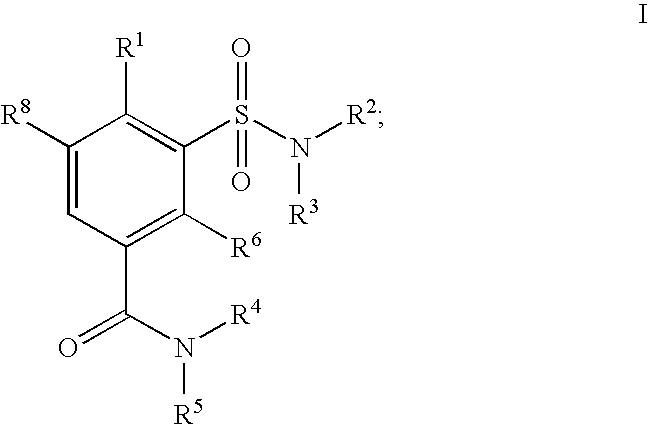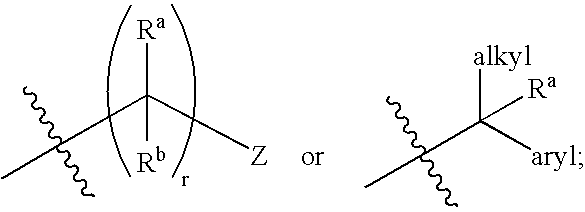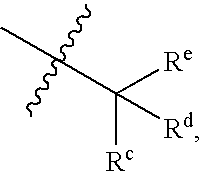Sulfamoyl benzamides and methods of their use
a technology of sulfamoyl benzamide and benzamide, which is applied in the field of new drugs, can solve the problems of causing a number of unwanted cns side effects, affecting the immune system, and affecting the immune system, and achieves the effect of preferentially high affinity for the cb2 receptor
- Summary
- Abstract
- Description
- Claims
- Application Information
AI Technical Summary
Problems solved by technology
Method used
Image
Examples
example 1a
Preparation of 3-(chlorosulfonyl)-4-(methylamino)benzoic acid (1.2)
[0601]
[0602]4-(Methylamino)benzoic acid (1.1, 3 g) was dissolved in 20 mL HSO3Cl and heated to 100° C. for 48 hours. The mixture was cooled to room temperature and carefully poured on ice. A white precipitate formed, was collected and dried to yield 3-(chlorosulfonyl)-4-(methylamino)-benzoic acid (1.2) as an off-white powder (1.96 g, 39% yield). MS analysis (m+1)=248.
Preparation of 4-(methylamino)-3-(morpholinosulfonyl)benzoic acid (1.3.Aa)
[0603]
[0604]3-(Chlorosulfonyl)-4-(methylamino)benzoic acid (1.2, 1.0 g) was dissolved in 20 mL of ethyl acetate and morpholine (Aa, 1.0 mL, 3 eq) was added. The mixture was stirred at room temperature for 2 hours, then extracted with 15 mL of 0.5M HCl. The organic layer was washed with H2O and brine, and the solvent evaporated to yield 4-(methylamino)-3-(morpholino-sulfonyl)-benzoic acid (1.3.Aa) as an off-white powder (0.30 g, 30% yield). MS analysis (m−1)=299.
Preparation of 4-(me...
examples 1b-1d
[0609]Compounds 1B-1D were prepared from 4-(methylamino)-3-(morpholinosulfonyl)-benzoyl chloride 1.4.Aa with N-((1R,2R,4S)-bicyclo-[2.2.1]heptanyl amine Bb (compound 1B), 6-methoxy-1,1-dimethyl-1,2,3,4-tetrahydronaphthalen-2-amine Bc (compound 1C) and 5-methyl-3-phenylisoxazol-4-amine Bd (compound 1D) respectively following the procedure described in Example 1A.
[0610]Compound 1B: 1H NMR (CDCl3), δ 1.26 (m, 5H), 1.58 (m, 5H), 1.89 (m, 1H), 2.33 (d, J=1 Hz, 2H), 2.91 (d, J=5 Hz, 3H), 3.07 (t, J=5 Hz, 4H), 3.72 (t, J=5 Hz, 4H), 3.89 (q, J=3 Hz, 1H), 5.78 (d, J=4 Hz, 1H), 6.58 (d, J=4 Hz, 1H), 6.74 (d, J=9 Hz, 1H), 7.87 (dd, J=9 Hz and 2 Hz, 1H), 7.92 (d, J=2 Hz, 1H).
[0611]Compound 1C: 1H NMR (CDCl3), δ 1.34 (s, 3H), 1.37 (s, 3H), 1.96 (m, 1H), 2.09 (m, 1H), 2.90 (d, J=5 Hz, 3H), 3.06 (t, J=5 Hz, 4H), 3.72 (t, J=5 Hz, 4H), 3.81 (s, 3H), 4.38 (m, 1H), 5.93 (d, J=9 Hz, 1H), 6.62 (m, 1H), 6.73 (m, J=9 Hz and 3 Hz, 2H), 6.89 (d, J=3 Hz, 1H), 7.03 (d, J=8 Hz, 1H), 7.76 (m, 1H), 7.97 (d, J=2 ...
example 1e
Preparation of 3-(isoindolin-2-ylsulfonyl)-4-(methylamino)benzoic acid (1.3.Ab)
[0613]
[0614]3-(Chlorosulfonyl)-4-(methylamino)benzoic acid 1.2 was reacted with isoindoline Ab following the procedure described in Example 1A. MS analysis (m−1)=331.
Preparation of 3-(isoindolin-2-ylsulfonyl)-4-(methylamino)-N-((1S,4R)-1,3,3-trimethylbicyclo[2.2.1]heptan-2-yl)-benzamide (1E)
[0615]
Method 1a
[0616]3-(Isoindolin-2-ylsulfonyl)-4-(methylamino)benzoic acid (1.3.Ab, 4 mg, 0.012 mmol) in 300 μl N,N-dimethylformamide and PS—N,N′-dicyclohexylcarbodiimide resin (15 mg, loading ca. 1.27 mmol / g) were combined with 1-hydroxybenzotriazole (2 mg, 0.015 mmol) and fenchyl amine (Bb, 1.5 mg, 0.010 mmol). The reaction was shaken for 24 hours, then PS-trisamine resin (9 mg, loading ca. 4.36 mmol / g) was added and shaken overnight. The reaction was filtered and the N,N-dimethylformamide evaporated. 3-(isoindolin-2-ylsulfonyl)-4-(methylamino)-N-((1S,4R)-1,3,3-trimethyl-bicyclo[2.2.1]heptan-2-yl)-benzamide (1E) wa...
PUM
| Property | Measurement | Unit |
|---|---|---|
| body weight | aaaaa | aaaaa |
| body weight | aaaaa | aaaaa |
| time | aaaaa | aaaaa |
Abstract
Description
Claims
Application Information
 Login to View More
Login to View More - R&D
- Intellectual Property
- Life Sciences
- Materials
- Tech Scout
- Unparalleled Data Quality
- Higher Quality Content
- 60% Fewer Hallucinations
Browse by: Latest US Patents, China's latest patents, Technical Efficacy Thesaurus, Application Domain, Technology Topic, Popular Technical Reports.
© 2025 PatSnap. All rights reserved.Legal|Privacy policy|Modern Slavery Act Transparency Statement|Sitemap|About US| Contact US: help@patsnap.com



